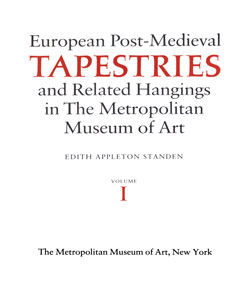Ecce Homo
After a painting by Quentin Metsys Netherlandish
Not on view
The bound Christ, humiliated and all but naked, mockingly draped in an imperial purple cloak and thorny crown, is presented to the jeering crowd, as described in the Bible (John, 19:5), the inscription woven in gilded silver, “ECCE HOMO” declaring ‘here is the man’. In a device popularized by Albrecht Dürer, the crowd is not actually represented; instead, it is as if his tormenters present Christ directly to us, the tapestry’s viewers, making us complicit in his degradation and rendering this hanging ideal as a tool for devotional contemplation and meditation.
This small hanging combines tapestry conventions, like the decorative border filled with beautifully observed fruit, flora and foliage, with compositional devices more typical of contemporary panel paintings, like the half-length devotional format, and the foreground ledge and slightly awkward, encroaching architectural setting. This tapestry’s design reuses a prototype almost certainly created in the workshop of the successful Antwerp-based artist, Quentin Metsys, and disseminated in numerous paintings; a painted version attributed to Metsys, particularly closely related to this tapestry’s design, is in the Doge’s Palace, Venice. Like The Met’s tapestry 32.100.389, this is one of a sizeable group of smaller-scale devotional tapestries produced by talented weavers almost certainly working in Brussels- the center of excellence of figurative tapestry weaving throughout the late fifteenth and the sixteenth centuries- and probably made on speculation for sale on the open market.
Due to rights restrictions, this image cannot be enlarged, viewed at full screen, or downloaded.


